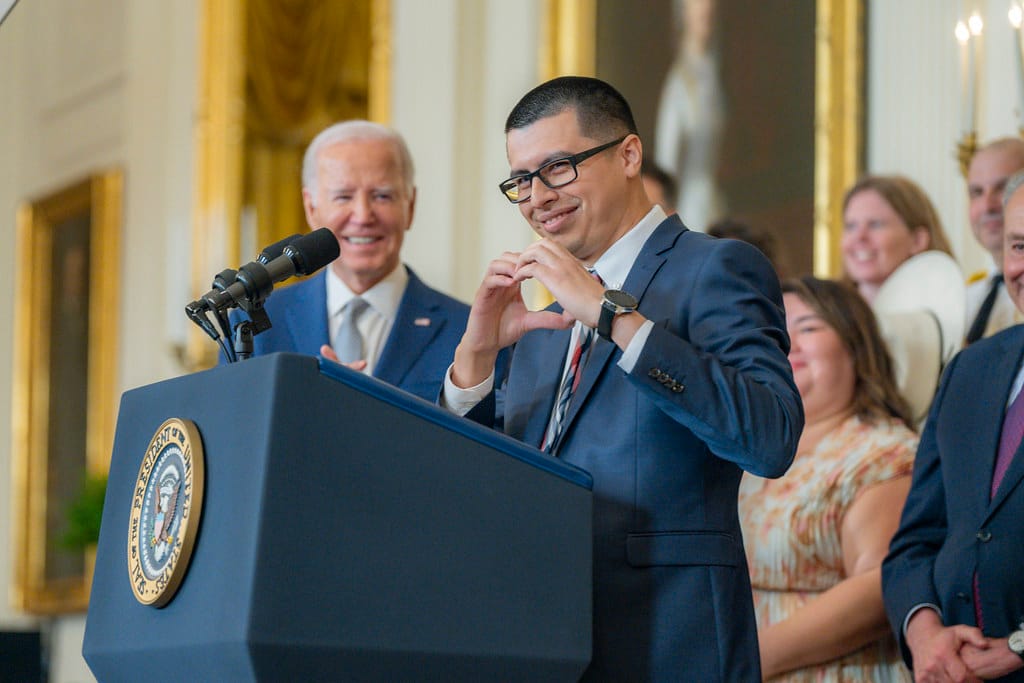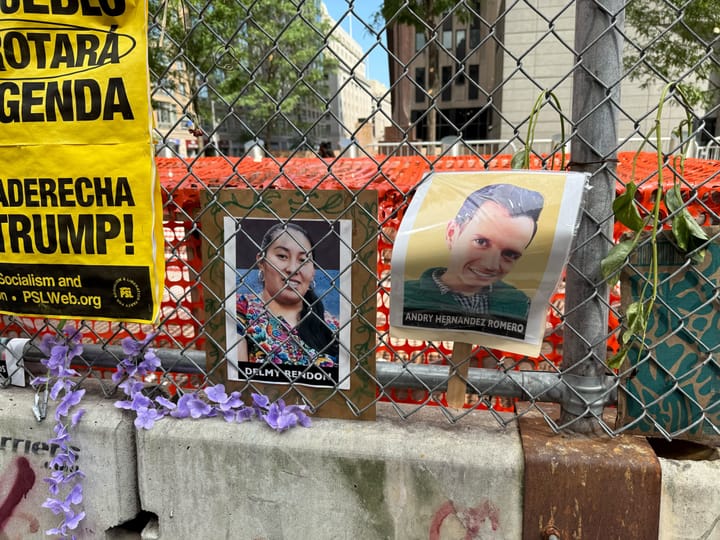Biden’s plan for undocumented spouses could reduce New York City poverty
We’re looking at potentially some 100,000 longtime residents of the state gaining access to permanent status.

Last week, President Joe Biden announced a federal program to allow undocumented spouses of U.S. citizens to pursue a path to citizenship. The action came on the heels of a heavy border restriction Biden had issued weeks before, and is probably an acknowledgment that he has to differentiate himself from Trump on immigration as the GOP tries to make the issue an electoral weapon ahead of this year’s elections.
It likely won't affect the surge of migrants who have arrived in the city, but, in theory, it could allow for more people to get work permits and report wage theft — and could lead to an overall reduction in poverty across the city.
Full details of the rule are still outstanding, but we know the general contours of the plan: people who are married to U.S. citizens, have been in the country for 10 or more years, do not otherwise have status, and are not ineligible due to criminal convictions or “threat to national security or public safety” can receive parole-in-place, which will generally permit them to apply for residency. This also goes for their children under 21.
It’s hard to gauge exactly what share of beneficiaries would be in New York City, but it’s a safe bet that it’s substantial. Pre-pandemic, and prior to the current waves of migrant arrivals, the city had a bit under 500,000 undocumented immigrants, a number that has been steadily declining but is still in the half-million range.
Migration Policy Institute estimates from 2019 point to about 96,000 undocumented people in the state being married to a U.S. citizen, and 55 percent of the entire undocumented population in New York having lived in the country for 10 or more years.
Counting children, we’re looking at potentially some 100,000 longtime residents of the state, concentrated in New York City, where 12 percent of residents live in mixed-status households, gaining access to permanent status and eventual citizenship. That will have consequences ranging from the economic to the social to the electoral, provided the program survives in court.
How it works, and who qualifies
Despite descriptions of this as providing a path to citizenship, it’s really more like clearing the path. These spouses are technically all eligible to apply for residency already, through the law’s existing programs for family reunification. The catch-22 is they can’t really do so from within the United States, because while you can go from one status to another, the law isn’t set up to allow people to go from no status to status without leaving the country and reentering.
A separate part of immigration law (part of Clinton’s heavy-handed 1996 immigration reforms, which more broadly moved towards criminalizing immigration) triggers a 10-year ban on reentry for people who leave the country after having lived without documentation for a year or longer. Basically, taking advantage of the available path to residency would simultaneously block someone from entering, just one of the many cruel contradictions of a poorly-designed system collapsing under its own weight. Under this rule, these people would receive parole, which is not a full status per se but a sort of discretionary pseudo-status. So far, parole-in-place has been available almost exclusively to military spouses, but this rule is an expansion of that.
It is almost certain to draw legal challenges, at least in part because parole has gone from a tool in relatively limited usage on a case-by-case basis to a pretty substantial part of domestic immigration policy over the past few years. The Biden administration has set up parole programs for Ukrainians, Venezuelans, Haitians, Cubans, Nicaraguans and Afghans in the past few years, and otherwise used it as something of a stopgap when faced with continued congressional inaction on immigration.
Downstream economic benefits
In addition to giving beneficiaries a shield from deportation, the program also would give people the ability to work on the books — which would likely raise their wages, make them eligible for Social Security and other benefits, and allow them to apply for subsidized health insurance.
It’s illegal to pay workers lower wages because of their immigration status, but wage theft remains a persistent problem across the state. Between 2017 and 2021, more than 127,000 workers were victims of wage theft in New York state, according to an analysis of federal and state databases by Documented. Not all victims of wage theft are immigrants, but Documented spoke to several undocumented immigrants who said they were paid substandard wages, likely because of their immigration status.
Undocumented people may also be more hesitant to report wage theft and other unlawful labor practices to the authorities, and experts say undocumented immigrants are often less willing to speak up because they fear deportation.
The problem of wage theft, of course, does not only apply to undocumented immigrants, but removing the threat of deportation will likely make people more willing to report unscrupulous employers.
Legal status would also mean that spouses and children of U.S. citizens would be eligible for other economic benefits, including Social Security wages, when they reach retirement age.
According to the comptroller’s office, undocumented immigrants across New York State paid $3 billion in taxes in 2021. They pay into Social Security and help fund Medicaid and Medicare but aren’t eligible for any of these benefits. As of 2021, 46 percent of undocumented New Yorkers lack health insurance, according to city data. Upon becoming U.S. permanent residents, those below a certain income threshold could qualify for Medicaid and other benefits, while those 65 or older or with certain disabilities could be eligible for Medicare. Others could obtain subsidized health insurance via the New York State marketplace. Permanent residency would also allow people to apply for SNAP and other benefits.
These benefits would be crucial for immigrant families, especially since undocumented immigrants have a higher poverty rate than immigrants with legal status. The undocumented poverty rate was 28.8 percent in 2017, compared to 22.1 percent among all immigrants, according to a report by the Comptroller’s office.
Potential political effects
The people who obtain legal residency via this program would, upon becoming citizens, also have the right to vote. In terms of raw numbers, this wouldn’t have that much of an effect: there are more than 19 million people living in New York State, of whom 13.1 million are registered to vote as of 2022. Just over 5.7 million votes were cast in the 2022 elections.
At the local level, however, the effects could be more salient. Since we don’t yet know the details of the program — and since it will likely face a legal challenge — it’s hard to say who or how many people will benefit, where they’ll be concentrated, or what their voting patterns would be if they became U.S. citizens. The people who would benefit from the program aren’t a large enough share of the population to sway federal elections, but they could affect things at the local or state level.
Who’s not included
All told, this program is both expansive in national scope but also incredibly targeted: most undocumented people would not benefit, nor would recently arrived migrants or people awaiting the outcome of an asylum grant. It would have little to no effect on the migrant surge in the city, since few, if any, of the migrants who have arrived in recent years have U.S. citizen spouses or parents. Still, it would provide significant material benefits for a portion of our undocumented population, and could also help reduce poverty citywide.




Comments ()